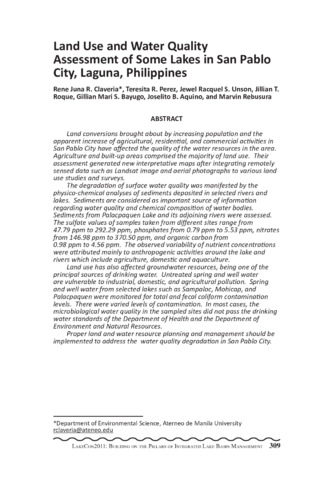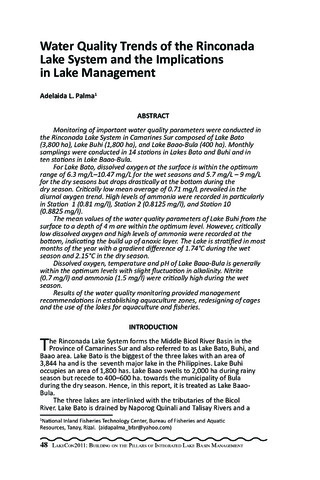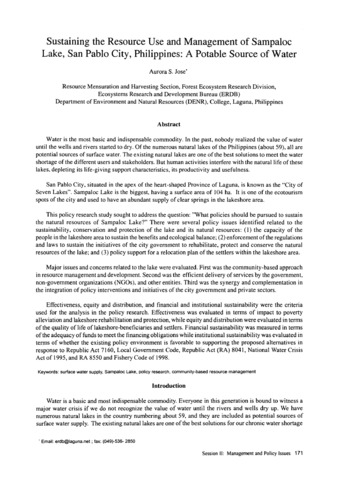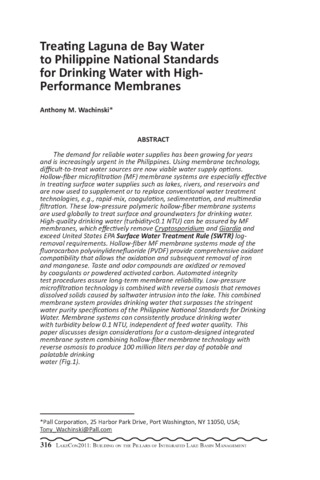Land use and water quality assessment of some lakes in San Pablo City, Laguna, Philippines
- Global styles
- MLA
- Vancouver
- Elsevier - Harvard
- APA
- Help
Share
Abstract
Land conversions brought about by increasing population and the apparent increase of agricultural, residential, and commercial activities in San Pablo City have affected the quality of the water resources in the area. Agriculture and built-up areas comprised the majority of land use. Their assessment generated new interpretative maps after integrating remotely sensed data such as Landsat image and aerial photographs to various land use studies and surveys.
The degradation of surface water quality was manifested by the physico-chemical analyses of sediments deposited in selected rivers and lakes. Sediments are considered as important source of information regarding water quality and chemical composition of water bodies. Sediments from Palacpaquen Lake and its adjoining rivers were assessed. The sulfate values of samples taken from different sites range from 47.79 ppm to 292.29 ppm, phosphates from 0.79 ppm to 5.53 ppm, nitrates from 146.98 ppm to 370.50 ppm, and organic carbon from 0.98 ppm to 4.56 ppm. The observed variability of nutrient concentrations were attributed mainly to anthropogenic activities around the lake and rivers which include agriculture, domestic and aquaculture.
Land use has also affected groundwater resources, being one of the principal sources of drinking water. Untreated spring and well water are vulnerable to industrial, domestic, and agricultural pollution. Spring and well water from selected lakes such as Sampaloc, Mohicap, and Palacpaquen were monitored for total and fecal coliform contamination levels. There were varied levels of contamination. In most cases, the microbiological water quality in the sampled sites did not pass the drinking water standards of the Department of Health and the Department of Environment and Natural Resources.
Proper land and water resource planning and management should be implemented to address the water quality degradation in San Pablo City.
Suggested Citation
Claveria, R. J. R., Perez, T. R., Unson, J. R. S., Roque, J. T., Bayugo, G. M. S., Aquino, J. B., & Rebusura, M. (2013). Land use and water quality assessment of some lakes in San Pablo City, Laguna, Philippines. In M. L. C. Aralar, A. S. Borja, A. L. Palma, M. M. Mendoza, P. C. Ocampo, E. V. Manalili, & L. C. Darvin (Eds.), LakeCon2011: Building on the pillars of Integrated Lake Basin Management (Second National Congress on Philippine Lakes) (p. 309). Los Baños, Laguna, Philippines: PCAARRD-DOST.
Type
Conference paperISSN
1656-8099Series
Summary of Proceedings No. 1/2013;Collections
- LakeCon2011 [30]
Related items
Showing items related by title, author, creator and subject.
-
Series: Summary of Proceedings No. 1/2013;
Water quality trends of the Rinconada lake system and the implications in lake management
Palma, Adelaida L. (PCAARRD-DOST, 2013)Monitoring of important water quality parameters were conducted in the Rinconada Lake System in Camarines Sur composed of Lake Bato (3,800 ha), Lake Buhi (1,800 ha), and Lake Baao-Bula (400 ha). Monthly samplings were ... -
Sustaining the resource use and management of Sampaloc Lake, San Pablo City, Philippines: A potable source of water
Jose, Aurora S. (Southeast Asian Regional Center for Graduate Study and Research in Agriculture (SEARCA), 2005)Water is the most basic and indispensable commodity. In the past, nobody realized the value of water until the wells and rivers started to dry. Of the numerous natural lakes of the Philippines (about 59), all are potential ... -
Series: Summary of Proceedings No. 1/2013;
Treating Laguna de Bay water to Philippine National Standards for drinking water with high-performance membranes
Wachinski, Anthony M. (PCAARRD-DOST, 2013)The demand for reliable water supplies has been growing for years and is increasingly urgent in the Philippines. Using membrane technology, difficult-to-treat water sources are now viable water supply options. Hollow-fiber ...





